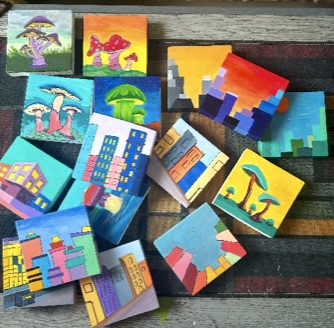The conversation began quite organically, in 2024, with Johanz Mercurio simply showing up at Thrive Art Gallery, talking about this project he and his brother, Jed, were engaged in: the “quads.” He says they’ve created over 300 artworks with plans of sharing them in an exhibition. Maintaining our mantra of inclusivity in aiding artistic development in the community, we entertained the idea and asked him to submit a proposal.
When he mentioned the tiny artworks on four-inch square wood blocks, I imagined Persian miniature paintings. Johanz says they painted on wood, which set me off a bit because wood is not entirely a popular medium for use with acrylic. But he and his brother Jed have the idea, and they both seem to want to commit to it, even planning four installments of the exhibition, each iteration with new artworks as addition.
When we started occupying the space at Atria for exhibitions, the artists who helped us put up the gallery discussed the idea of hoping to push forward a way of presenting the artworks in thematic order, presenting new ideas, helping define what contemporary Ilonggo art is, and eventually inspiring the artists to connect with the audience in a space beyond the usual laissez-faire. We, of course, thought of how this exhibition could align with that goal.

Eventually, we realized that what matters more than how the artwork is presented is how it was created. It is important to point out how art is a practice, and that’s the very thing that Johanz and Jed did almost daily in the confines of their living room during the pandemic; eventually, after the pandemic in the middle of their busy workday, and until Johanz decided to do art full-time. They both committed to the practice. The exhibition shows how they started with images that document their love for pop culture, their adventures in nature, the people around them, and sometimes the ennui in between. In his proposal, Johanz pitched the title “Breathe”. With previous exhibitions, we normally ask the artist to define the title vis-à-vis the artworks presented, but for Johanz and Jed, when we saw the artworks overcoming their walls in their house during a studio visit, we thought maybe that really was the appropriate title, just “Breathe”.
Then came the installation time, we thought of building layers of one-inch shelving to house each painting to enable the audience to arrange and rearrange them. This is one of the intentions that the exhibition want to communicate: the little moments in which people could get positively lost in creativity. Personally, I’ve been looking at the 1,000 tiny artworks show that is regularly put up at Back Room Gallery in Kuala Lumpur, Malaysia. I like how they make space for every artist as if the exhibition is a survey of what artworks are being produced in the environment where the gallery is situated. We’ve done something quite similar to this in 2013, but with slightly bigger sizes, in an exhibition we called “Blend” at Cinematheque Iloilo’s gallery. Somehow, we were able to visualize the exhibition.
The challenge was how to segregate the works on the walls. Should we show the progression of their outputs? Should we stick with putting the artworks with similar subjects together? Should we just put them randomly on the wall and trust our instincts? Surely, what we wanted to highlight was variety in uniformity, and with over 300 artworks, we had a lot of room to play with. In the end, we decided to divide the gallery into two exhibition components, putting the tiny paintings in one room and the framed ones in the other. This somehow bridged all curatorial intentions.
In a way, the artists and the gallery team also enjoyed having guests around during the installation. Johanz and Jed would point out how painting on a small canvas is a way for them to rid themselves of being overwhelmed. Seeing a finished artwork also gives them a sense of accomplishment that fuels them to take on another wood block. Eventually, they adopted this process and made bigger artworks using the blocks they had previously created. In a way, they were able to simulate play, quite strongly evident in Jed’s playful and whimsical abstractions. If anything, what exudes in the whole body of work is how the brothers collaborated and enjoyed the process.
Perhaps, what we will remember most about this exhibition is its offer of multiple ways of seeing: two hundred landscapes, twenty variations of the sunset, or a triptych of a single subject. Each quad serves as a mode of meditation, transforming the exhibition into a resonant space and creating a room where the artists breathe with their audience.